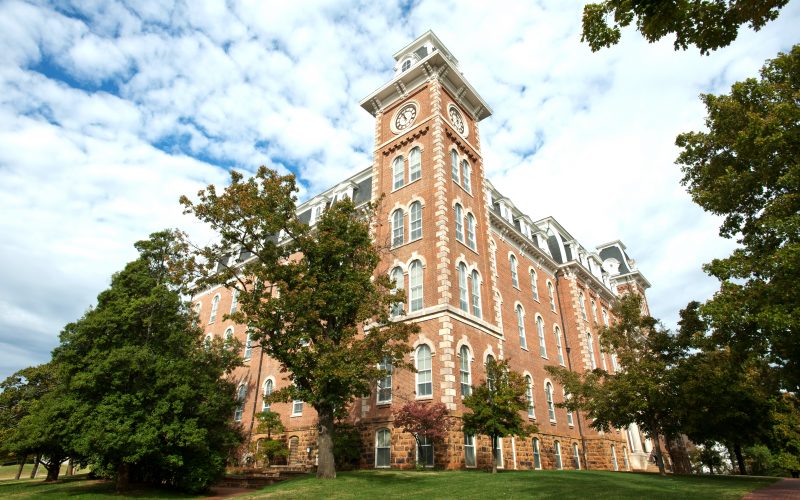 “The Hill skyrocketed from 16,035 total students to nearly 24,000…that’s a growth rate of 70 percent”
“The Hill skyrocketed from 16,035 total students to nearly 24,000…that’s a growth rate of 70 percent”
“Parking decks, built for the convenience of students who commute have begun dominating the skyline as much as architectural gems like The Blair Library, Old Main, or Hillcrest Towers (if you’re into that) do.”
U of A Expansion Makes Townies Cringe (And Give Thanks)
By Martin Bemberg
In Fayetteville there is doubtless no trend more conspicuous, nor more discussed, as the growth of The University of Arkansas. (Next on the list is likely the ensuing traffic and manic rate of housing development.) Over a ten-year period — from Fall 2002 through Fall 2012 — enrollment on The Hill skyrocketed from 16,035 total students to nearly 24,000. While you take a moment to attempt some eighth-grade algebra in your head, don’t – sit down and pour yourself a strong drink: that’s a growth rate of 70 percent. Yes, seventy.
To put that into goofy perspective, 70 percent more is how many more photos of breakfast were shared on Facebook via smartphone last year (this according, more or less, to tech giant Cisco Systems). To put it into proper perspective, in the ten years between the 2000 and 2010 censuses, the population of Fayetteville grew by just 15 percent.
So what does this mean? It means ‘Congratulations! You just read a bunch of numbers!’ Numbers aside, though, a real question remains. And it is not just a question — it is the question. What does the enrollment explosion mean for the U of A? And more importantly, what does it mean for this fine city?
Well, first off, it means a lot more money. For the school and for the city too. In the past ten years, the number of young people of means, who spend money at bars, restaurants, and movie theaters, has also grown by 70 percent. (Tax revenue, baby!) And of course for the University, it means a lot more money. Application fees, room and board if they live in dorms, “ID” fees, new student fees, the Arkansan Non-Resident Tuition Scholarship Award Program Fee, facility fees, health fees, media fees, network and data systems fees, student activity fees, transit fees, and of course, tuition. Which is rising steadily, despite the explosion in enrollment. The University of Arkansas Report 2010 attributes this to state-appropriations shortfalls and — wait for it… “lower than expected enrollment rates.”
Ummm, Who Calls B.S.?
But more students means more congestion too. It’s clear to everybody, for example, that in the summertime, when the livin’s easy and the students have all gone back home, traffic on the street thins out tremendously. It thins out too in other places. Ask Wade Ogle, owner of JR’s Lightbulb Club. He says of summertime, when the livin’s easy, so is managing the bar, because “people are usually out doing summer fun things,” instead of drinking indoors.
One area of town that has not thinned out is that which surrounds the University. Neighborhoods formerly known colloquially as ‘Student Ghettos’ (mainly north of Maple and east of Garland), are being bought up with mechanical fury by the University of Arkansas. Homes which once housed graduate and undergraduate students alike, as well as middle class families and professors, are being bought now at prices that connote collusion in home-appraisal, gutted or demolished, and becoming a part of campus proper. The neighborhood in which I spent my first four years — off Leverett Avenue on Storer Street, just up the hill from the Unitarian Universalist Fellowship of Fayetteville – is in danger of disappearing.
The Landscape Is Changing
Parking decks, built for the convenience of students who commute have begun dominating the skyline as much as architectural gems like The Blair Library, Old Main, or Hillcrest Towers (if you’re into that) do. However, many find the most recent parking deck — which lines Garland Avenue across the thoroughfare from The Quads — to be a fairly successful synthesis of what architects call ‘form vs. function.’
There are transformations in many of the areas adjacent to campus, and many residents of those believe the University’s increased enrollment is becoming a detriment to their quality of life there, as well as to their property values, and some even have concerns about their safety, because of the influx of rowdy youngsters.
Take the residents of the Sang Valley Neighborhood.
In the spring of 2012, an ordinance-revision proposal made its way to the Fayetteville City Council, which would abolish a long standing occupancy limit of three non-related persons per shared living space. While the ordinance seems at first antiquated, its amending, to up the occupancy limit to five persons would have vast impacts on neighborhoods like Sang Valley, which until recently was known for its communitas and tranquility. When, according to the City Clerk’s Office, 2000 mayoral candidate Paula Marinoni and her attorney, Bob Estes, proposed that the occupancy limit be changed, what many on the City Council who were responsible for the measure passing probably did not know, is that Marinoni was, presumably, planning to develop a (presumably) massive student housing complex on a large plot of land adjacent to the Sang Valley Neighborhood. The development as planned could not be built without the upping of the occupancy limit.
Community organizer Kathy Short (largely responsible for the recent formation of Fayetteville’s Town & Gown Committee) and the 2008 mayoral race’s second runner-up, Walt Eilers — among countless others who felt ignored by their representatives — argued before the Council their frustration with the City’s unwillingness to do anything but the University’s bidding. As a result of the ordinance’s approval — all but Aldermen Mark Kinion and Sarah Lewis dissenting — several homes, including Short’s, have gone up for sale, their values having plummeted at the news of adjacent student housing developments, and the eminent hollerin’ and beer binges.
This incident, and the ongoing trend of which it is the vanguard banner, is further proof of what most of us know already: The University of Arkansas is Fayetteville’s cashcow, plain and simple. It would be difficult to argue otherwise, with the exception of annual events such as Bikes, Blues and Barbecue, The Walmart Shareholder’s Meeting and perhaps someday, the Joe Martin Stage Race.
The Gray Areas Of The Matter
Where would this city be without an esteemed research university, which deservedly boasts the nation’s most prestigious architecture department, business school, creative writing program (next, perhaps only to the world-famous Iowa Writers Workshop), and without a doubt the best Master’s program in literary translation, headed by the renowned Dante and medieval French romance scholar Dr. John DuVal? Not to mention outstanding programs in poultry science, food science, horticulture, and…you name it. (Sit down while doing this; it will take a while.)
Where would we be? Probably not here. These hills would be clanned-up, perhaps exclusively, with the Scotch-Irish descendants to whom we owe the transplant of Appalachian culture into the Ozarks.
It is the University of Arkansas, in one way or another, which has brought almost all of us here, and it is the very people it has attracted which make Fayetteville, in the opinion of many, the best place to live in America.
The University of Arkansas’ enrollment explosion, and expansion of locale, has angered many, displaced a few, and at the same time made the school a serious contender, eventually, for ranking among the best public universities in The South. The University of Arkansas is also to be thanked for making this town what it is in many ways. Categorically ¡buenisimo! and the object of envy for nearly every visitor. Given these notions, which I happen to think approach fact, are proof that we can fight the good fight to preserve our neighborhoods, and thank our lucky stars at the very same time.
Where else in this world can you say that?
Only in Fayetteville, Arkansas — the greatest place on Earth(?).










